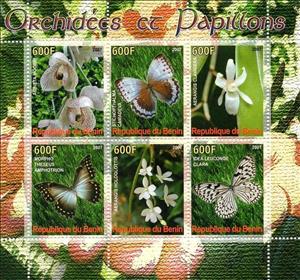Mini Sheet: Otrchids and butterflies (Cinderellas 2007)
Otrchids and butterflies (Cinderellas 2007)
01 January (Cinderellas ) within release Republic of Benin goes into circulation Mini Sheet Otrchids and butterflies face value 3600 West African CFA franc
| Mini Sheet Otrchids and butterflies in catalogues | |
|---|---|
| Colnect codes: | Col:BJ 2007-02 |
Mini Sheet is square format.
Also in the issue Republic of Benin:
- Stamp - Rotschildia jacobeae face value 600;
- Stamp - Asic flammeus face value 600;
- Stamp - Aglia tau face value 600;
- Stamp - Bee face value 650;
- Stamp - Bee face value 650;
- Stamp - Butterfly face value 650;
- Stamp - Butterfly face value 650;
- Stamp - Bee face value 650;
- Stamp - Butterfly face value 650;
- Mini Sheet - Owls and butterflies face value 3000;
- Stamp - Ninox scutulata face value 300;
- Stamp - Actias luna face value 500;
- Stamp - Ninox rufa face value 700;
- Stamp - Atrophanuera dasadara face value 300;
- Stamp - Ninox boobook face value 500;
- Stamp - Cithaerias merolina face value 700;
- Mini Sheet - Butterflies and owls face value 3600;
- Stamp - Nyctea scandiaca face value 600;
- Stamp - Neoris galerope face value 600;
- Stamp - Surnia ulula face value 600;
- Mini Sheet - Otrchids and butterflies face value 3600;
- Stamp - Acineta moorei face value 600;
- Stamp - Stichopthalma camadeva face value 600;
- Stamp - Aerangis clavigera face value 600;
- Stamp - Morpho theseus amphotrion face value 600;
- Stamp - Aerangis hologlottis face value 600;
- Stamp - Idea leuconoe clara face value 600;
- Mini Sheet - Butterflies and bees face value 3900;
- Mini Sheet - Pekin 2008 face value 2*650;
- Stamp - Michael Jordan face value 200;
- Stamp - Shaquilles O'Neil face value 200;
Mini Sheet Otrchids and butterflies it reflects the thematic directions:
Butterflies are insects in the macrolepidopteran clade Rhopalocera from the order Lepidoptera, which also includes moths. Adult butterflies have large, often brightly coloured wings, and conspicuous, fluttering flight. The group comprises the large superfamily Papilionoidea, which contains at least one former group, the skippers (formerly the superfamily "Hesperioidea") and the most recent analyses suggest it also contains the moth-butterflies (formerly the superfamily "Hedyloidea"). Butterfly fossils date to the Paleocene, which was about 56 million years ago. Butterflies have the typical four-stage insect life cycle. Winged adults lay eggs on the food plant on which their larvae, known as caterpillars, will feed. The caterpillars grow, sometimes very rapidly, and when fully developed, pupate in a chrysalis. When metamorphosis is complete, the pupal skin splits, the adult insect climbs out, and after its wings have expanded and dried, it flies off. Some butterflies, especially in the tropics, have several generations in a year, while others have a single generation, and a few in cold locations may take several years to pass through their whole life cycle. Butterflies are often polymorphic, and many species make use of camouflage, mimicry and aposematism to evade their predators. Some, like the monarch and the painted lady, migrate over long distances. Many butterflies are attacked by parasites or parasitoids, including wasps, protozoans, flies, and other invertebrates, or are preyed upon by other organisms. Some species are pests because in their larval stages they can damage domestic crops or trees; other species are agents of pollination of some plants. Larvae of a few butterflies (e.g., harvesters) eat harmful insects, and a few are predators of ants, while others live as mutualists in association with ants. Culturally, butterflies are a popular motif in the visual and literary arts.
The Orchidaceae are a diverse and widespread family of flowering plants, with blooms that are often colourful and often fragrant, commonly known as the orchid family. Along with the Asteraceae, they are one of the two largest families of flowering plants. The Orchidaceae have about 28,000 currently accepted species, distributed in about 763 genera. The determination of which family is larger is still under debate, because verified data on the members of such enormous families are continually in flux. Regardless, the number of orchid species nearly equals the number of bony fishes and is more than twice the number of bird species, and about four times the number of mammal species. The family also encompasses about 6–11% of all seed plants. The largest genera are Bulbophyllum (2,000 species), Epidendrum (1,500 species), Dendrobium (1,400 species) and Pleurothallis (1,000 species). The family also includes Vanilla (the genus of the vanilla plant), Orchis (type genus), and many commonly cultivated plants such as Phalaenopsis and Cattleya. Moreover, since the introduction of tropical species into cultivation in the 19th century, horticulturists have produced more than 100,000 hybrids and cultivars.


